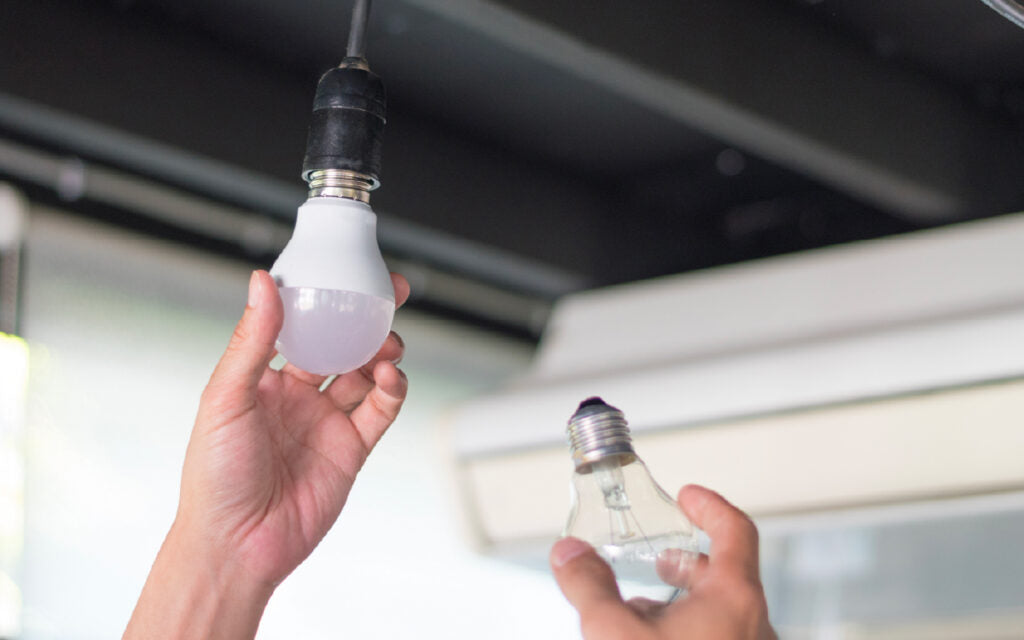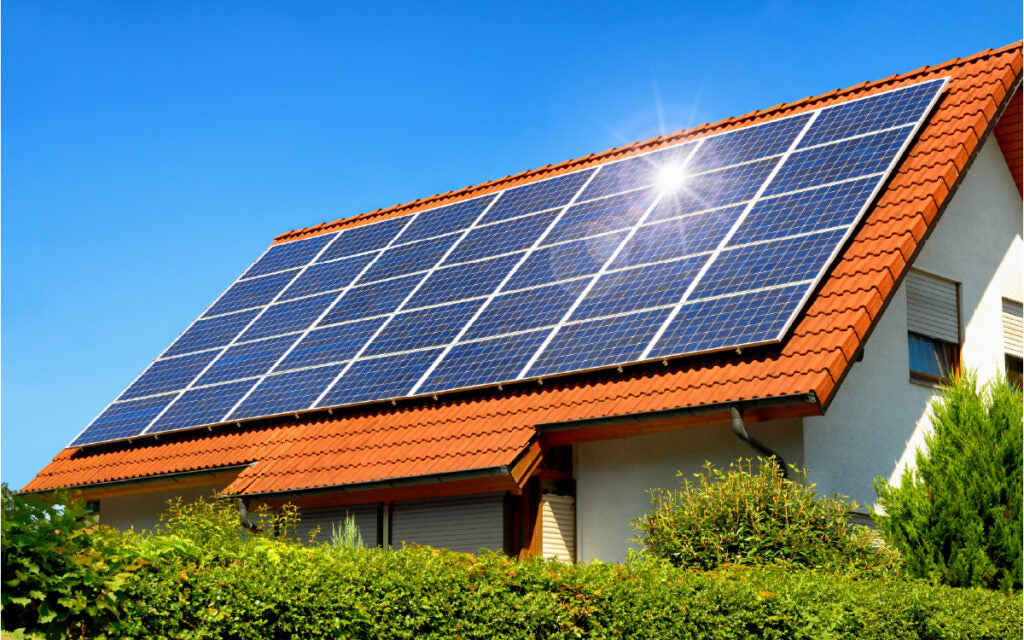There isn't any reason to doubt that sustainable, eco-friendly products are a good beginning toward transforming our home into a low-carbon house. But given that most of the homes that will be present by 2050 have been constructed, upgrading the current buildings is an important measure. The popular belief is that a single individual can’t do much for the Earth’s environment. But the fact is that if everybody puts little effort into making improvements in their personal lives, the effect on sustainability will be huge. Change starts at home. So, this list of 10 sustainable products will help us to make our homes greener and live better.
LED or CFL lights

Lighting contributes to around 9% of an average house's electricity consumption. Replacing all the existing light bulbs with LED light bulbs is an inexpensive and easy way to minimize electricity costs and overall ecological impact. LED lights use 80% less energy than incandescent lights on average. These improved lights also live around 20 times longer than standard bulbs, which means fewer of them wind up in landfills. One other advantage of LED lights is the degree of heat they produce. Since regular bulbs create a lot of heat, the air conditioner needs to run more in the summertime to compensate. LED lights produce less heat, which can indirectly and directly save additional energy. LED bulbs have also changed over time to meet various requirements, from discreet lighting to dimmer switches.
You might also like: A Guide to Picking the Best Outdoor Lights
Compost station
Most localities collect and process recyclable materials; some also collect compostable food scraps and yard trash. To simplify recycling and composting, keep garbage and recycling containers in areas other than the kitchen. Since the recycling bin is usually far away, a lot of recycled waste is discarded in home offices. Food scrap accounts for 50% of household trash. Discarded food scraps serve no use. However, with a compost bin at home, those scraps may be converted into fertilizer for plants. Get a compost station with a tight lid to avoid pests and ensure that the hatch is secure at the bottom, so removing fertilizer becomes easy.
Low-flow showerheads and water-efficient toilets
Traditional showerheads consume about five gallons of water per minute. This rapidly adds up, especially if numerous people are bathing in the house. Showering makes for roughly 17 percent of a typical family's domestic indoor water usage. Low-flow showerheads utilize less than two gallons of water per minute, saving water and lowering water bills. These showerheads use less water, and by doing so, they lessen the strain on water heaters, saving energy.
Toilets are by far the most common source of water use in the house, accounting for roughly 30% of the typical house's indoor water usage. Traditional toilets can consume up to six gallons of water per flush, but modern and more efficient toilets use one gallon or less. Reduce water consumption and cut costs on water bills by switching to water-efficient toilets.
Attic fans and attic insulation
As the temperature rises and our roofs are notorious for trapping the sun's heat, the attic is significantly hotter than the rest of the house throughout the summertime. An adequately insulated attic will operate as a firm seal for the air inside the house, preventing cool air from escaping. As a result, HVAC systems don't need to work harder. The place of residence determines the degree of insulation required. Hire a professional to insulate the attic with a range of materials thoroughly.
Adding an attic fan is another fantastic option to save electricity on cooling and heating the house, and lessen the possibility of humidity buildup inside the attic. Attic fans are installed on the roof and exhaust hot air from the attic, keeping the house cool during the summer and lowering the air conditioning expense. These are especially effective if it is an already adequately insulated attic. You may regulate attic fans on a thermostat to switch on when the temperature in the attic exceeds a specific level. There are also solar-powered choices for more environmentally friendly living.
Solar Panels

Solar panels will lower energy use and cost. They are a superb way to practice eco-friendly living at home. Over time, the panels would pay for themselves and dramatically decrease a household's carbon impact.
A homeowner has two alternatives for solar panels – leasing or buying:
- Leasing requires a down payment and interest, with the leasing company controlling and maintaining the solar panel for the duration of the lease.
- Buying doesn't require an interest payment, but upkeep is the homeowner's obligation once the initial period of the contract expires.
Do note that if a homeowner sells their home while leasing a solar panel, the new homeowner will become a part of the lease.
In most situations, the lease fee is less than the power bill, and if solar panels are bought, there will be no electricity bill. However, there might be a monthly charge. The utility provider pays the fee to attach the solar panels to the power grid. Solar panels are a great way to save energy by generating one's own, and they pay for themselves in 10 to 20 years.
Tankless water heaters
Conventional heating systems utilize gas to heat around 50 to 70 gallons of water, even when there is no use for that water. A lot of energy can be saved by turning it down to just a few degrees, from 105 to 100 degrees, and wrapping it in an insulating wrap. A tankless water heater is a much better alternative. It only warms the water when it's required, and it only uses power when it's turned on. It will also function effectively with solar panels as it is electric. As gas water heaters typically survive 12 to 15 years, thousands of them are discarded yearly. Tankless water heaters are substantially smaller and last roughly twice as long as traditional heating systems, resulting in less landfill waste. Replace a gas water heater with a tankless one to conserve energy.
Energy-efficient appliances
While buying an appliance, choose the energy-efficient model for a more sustainable lifestyle. Look for Energy Star ratings when buying home equipment such as washing machines, dishwashers, dryers, refrigerators, and ovens. The label informs customers that a third party has confirmed that the product uses minimal water and energy. They are more expensive than standard appliances. However, decreased water and energy expenditures will balance this.
Eco-paints and wallpapers
There are several eco-friendly paints available to paint the house. Most eco-friendly paints are soluble in water and utilize resin and plant oils to create a solution, with colors derived from plant colors or minerals. Green alternatives for cleaning and preparing walls are also obtainable, as are eco-friendly wood varnishes and waxes. Some examples of eco-friendly wallpapers are natural coverings created from cotton, wool, and hessian.
Natural products for floors and walls
Natural solutions will help to keep a house free of chemicals. Materials sourced from nature can be used to build walls. The walls need to be airtight yet permeable for moisture to escape. Don't build artificial walls to conceal natural insulation. Clay and lime plasters are organic, permeable, and versatile.
There are various natural options for flooring. Hardwood is the most preferred option. Ensure the product is sustainably made. Look for the Forest Stewardship Council certification.
Rubber, cork, and Marmoleum are some of the other natural flooring alternatives. Checking the supply chain ensures that the products are 100% natural.
Sustainable cleaning products

There are many locally sourced shampoos with minimal usage of chemicals. These products are not only good for the environment but also for the hair. Products such as eco-friendly detergents and dishwashers keep the house clean without harming the environment.
Also, check out: How to Make the Most of Your Spring Cleaning
Product Selection
China LED Pendant Matt Black: This sleek black light fixture lights up the house. It’s a classic piece that is not only stunning but also energy-efficient. The fixture is impeccably crafted with a blend of modernity and tradition.
1.2 Watt LED Hanging Ceiling Lamp with Cylindrical Glass Shade, Red: Buy this beautiful hanging pendant light to add elegance and beauty to the house. It is packed with features, including a 1.2W embedded LED that emits a red shade hue for a tailored experience. It comes with a cover for easy ceiling installation.
Conclusion
Small changes go a long way. Whether switching to something as simple as sustainable cleaning products or making a significant change such as installing solar panels, these changes will improve our lives without sacrificing our lifestyle. So, we must use sustainable products for the Earth, our well-being, and our happiness. Check out Casaone for the best deals on sustainable products. Shop now!

